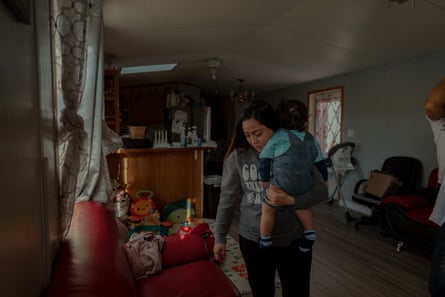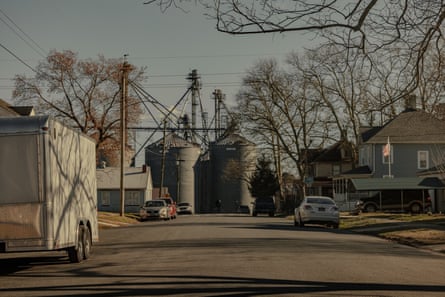When Emanie Dorival moved to Seaford, Delaware, she was welcomed by a horrible stench. The smell came from rows and rows of chicken houses that hold thousands of birds and are located near mobile home parks, churches and single-family homes in this largely rural community.
“It’s like poop mixed with rotten eggs,” said the Haitian-born woman. “It’s part of the environment. People get used to it. I cannot get used to it.”
Seaford is located on the Delmarva peninsula, a region that produces billions of pounds of chicken meat for America’s dining tables each year. But all that meat production comes with a dirty legacy, represented not only by the ammonia-laden fumes spewed from chicken farms, but also by the hundreds of thousands of tons of poultry manure, sludge, egg shells and other detritus generated annually.

Now, a new industrial use for chicken waste is being considered, but it could create new problems for the working-class rural region: a major proposed biogas plant would transform 250,000 tons of poultry waste each year into methane and other byproducts. Environmental and civil rights groups are challenging the plan, saying it would increase air and water pollution and pose significant health risks to nearby residents, many of whom are Black or immigrants from Haiti and Latin America who speak limited English.
Dorival, a family nurse practitioner who runs two clinics in the region that serve mostly immigrants who work at the chicken farms, wondered why the proposed biogas system was planned near homes. “The way I see it, every human being should have a right to clean air, water and food, without having to fight for that right,” she said.


The planned Bioenergy Innovation Center in Seaford would be developed on a 225-acre site where Bioenergy Devco, the biogas plant’s would-be owner, currently runs a composting operation. The property is surrounded by wetlands, freshwater ponds and residential areas, including a mobile home park that can be reached on foot.
The question of what to do with all the waste that stems from the region’s poultry production is already weighing on the local community. Currently, manure is often applied to fields as fertilizer – but that presents environmental problems, as the manure contains nitrogen and phosphorus that can run off into waterways, including the Chesapeake Bay, and is lethal to fish and crabs.

The proposed biogas facility’s proximity to the region’s waterways – as well as Black and immigrant communities – also troubles local environmentalists. The Delaware chapters of the ACLU and the NAACP were among those who filed a complaint with the Environmental Protection Agency (EPA) earlier this year alleging that the local government discriminated against residents of color by failing to translate educational materials, offer opportunities for public participation and accommodate residents who don’t have internet access. The complaint was spearheaded by the Socially Responsible Agriculture Project.
The Delaware department of natural resources and environmental control declined to comment. A spokesperson for Sussex county said the county doesn’t comment on pending or active legal matters. In response to questions about its plans in Seaford, Bioenergy Devco, which is not named in the EPA complaint, said it was “committed to continuing to educate our community about the facility”, referencing a public document it submitted during the permitting process. It also encouraged residents to attend its events.
There are approximately 2,300 biogas systems operating in the US, according to the American Biogas Council, a trade association for the industry. While most of the systems process wastewater or operate at landfills, about 300 are located on farms. In North Carolina, residents lodged a civil rights complaint against one such project, claiming the plan to convert hog waste into biogas would pose pollution hazards to nearby Black and Latino communities. And in California, groups have been fighting against biogas production at industrial dairy waste facilities near low-income, predominantly Latino communities of the San Joaquin Valley.
Biogas facilities pose various potential environmental risks. Such systems can emit greenhouse gas emissions and threaten water sources. Biogas is also potentially explosive.
In Seaford, the new biogas system would result in chicken waste being trucked to the plant nearly 200 times a day, by Bioenergy Devco’s estimate. The methane produced at these facilities would also then be transported as compressed gas to a regional natural gas pipeline, and excess wastewater would be hauled away to be treated and discharged into a nearby river. Residents worry about this near-constant flow of heavy-duty vehicle traffic.

“They trying to put these in places where they think people don’t care,” said Leon Lofland, 71, a Black truck driver who has lived in the Sussex Manor mobile home park, a sprawling lot of dozens of trailers about a half mile from the proposed biogas system, for a decade.
Lofland is opposed to the biogas facility. “They don’t give us no respect,” he said.
His neighbor Maria Celayos, 32, lives with her four children and husband in a three-room mobile home at the park. Outside her trailer, a pink toy car was parked against a tree and a pink scooter lay on the lawn. Her husband was fixing a tire on the car he uses to transport workers to and from a nearby chicken farm, the Mexican immigrant said, speaking in a mix of Spanish and English. She said she was particularly concerned about the added truck traffic.
“I don’t want trucks on my street because of my kids,” Celayos said, recalling how a few years back a child was hit and killed by a vehicle on the busy street that runs alongside the park. She said government officials were being disrespectful by not meeting with the community to explain the plan. “We’re immigrants, but we have rights,” she said.

On a nearby street, Sharon Smith, 48, who is Black and works at a container manufacturer, wondered if the new facility would lead to water contamination. “I don’t think I want it because I don’t want them to mess up my water,” she said, while noting she wanted to know more about the plant.
An environmental assessment paid for by Bioenergy Devco found the facility wouldn’t cause any significant air or water pollution. Environmental groups, though, say the company’s permit application is incomplete, contradictory, incoherent and legally questionable. They say that anaerobic digesters have been demonstrated to contribute nitrate contamination that can leach into groundwater; that refining the biogas into methane would generate emissions that would affect air quality and contribute to the climate crisis; and that the approximately 60,000 gallons of wastewater generated each year would add pollution to an already distressed river.
Michael J Kleeman, a professor of civil and environmental engineering at the University of California, Davis, who has researched the air quality implications of biogas production and use, said after reviewing the plans that they seemed to “appropriately address all the concerns related to air and water pollution”.
“Clearly it will be an industrial facility, but I don’t see any immediate cause for concern that it will worsen air pollution or water pollution in the surrounding region,” he added.

“It can be done with minimal environmental impacts if it is designed and operated correctly,” he said in an email. “But a better planning process would have sited this facility further away from residential areas.”
The surrounding community is within five miles of various identified sources of contamination, including hazardous waste and brownfields, according to EPA data. The Blades Groundwater Superfund Site runs along Seaford. Information from the Centers for Disease Control and Prevention shows the community is at a high risk of chronic health conditions and vulnerable to environmental risks.
Other Sussex Manor mobile home park residents said no one from a government agency or Bioenergy Devco had visited to explain the plan to them. They only heard about it from activists in recent months, though the plant was proposed in 2020.

Dorival, the health practitioner, said she saw a lot of people at her clinic with chronic illnesses, including asthma among children and adults. She said patients who worked at the chicken farms were already breathing in noxious fumes on the job.
Any new pollution brought by the new biogas system would simply add to the environmental hazards the residents in Seaford are already exposed to, she argued. “These people are already in a vulnerable state,” she said.
